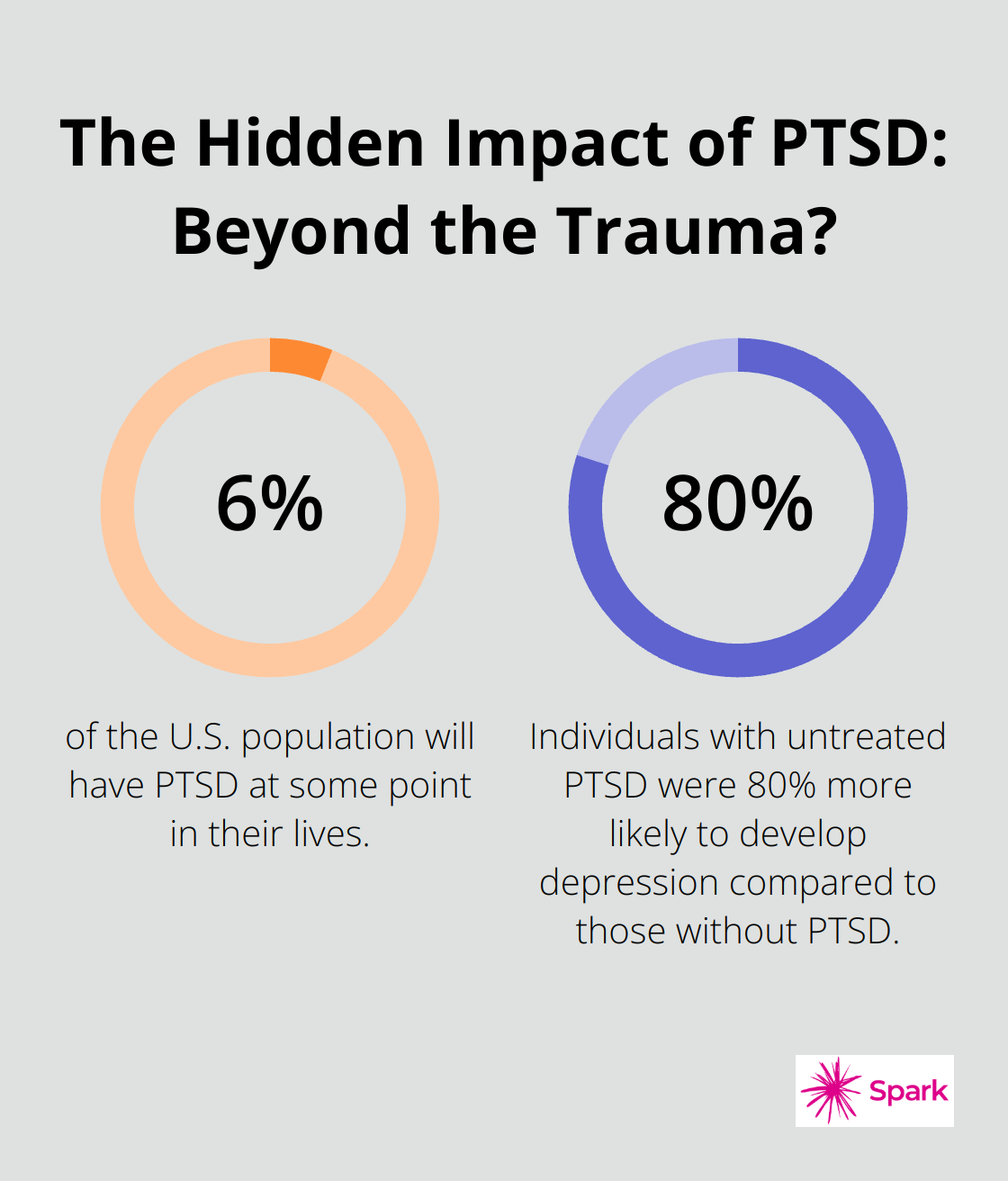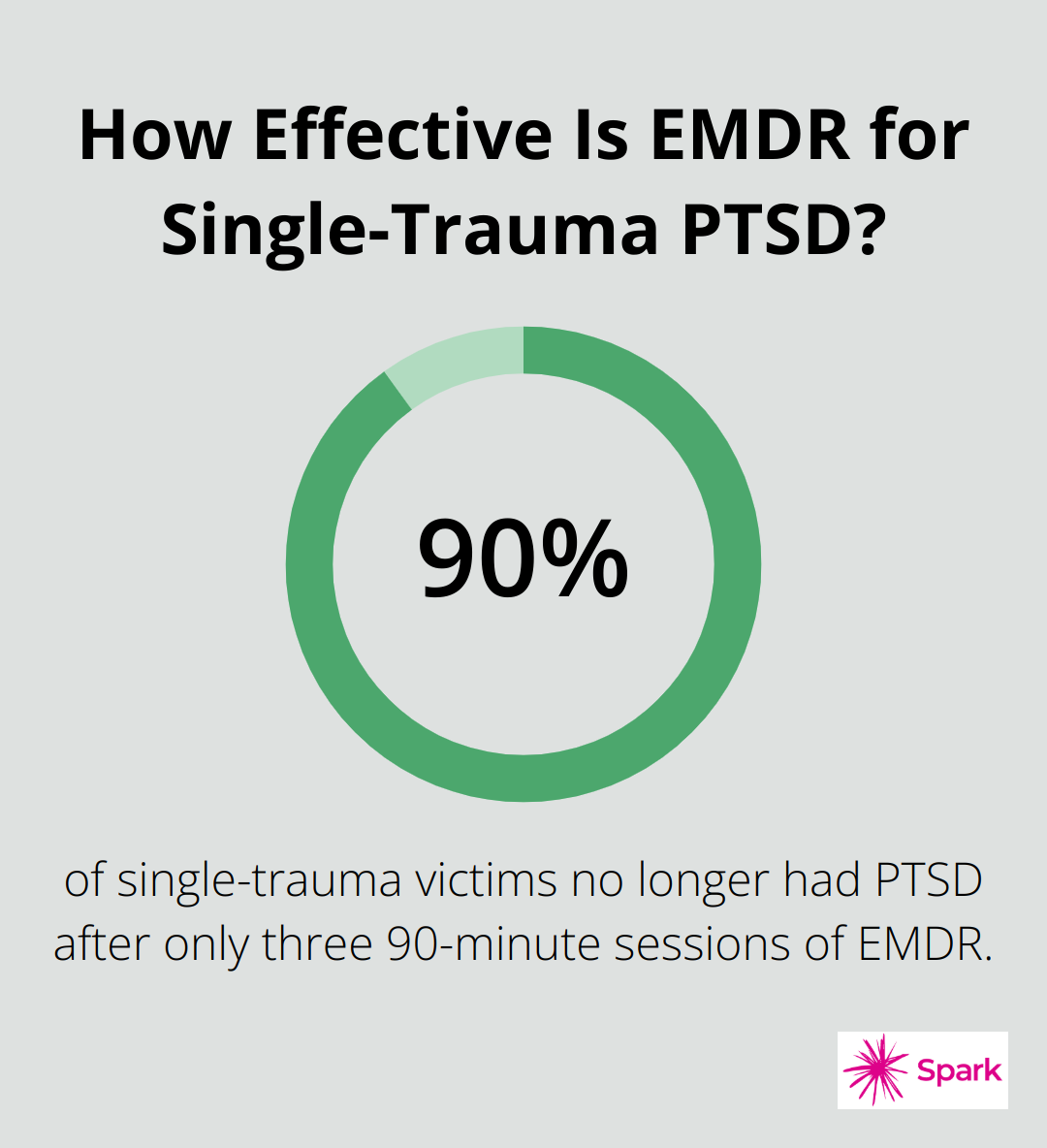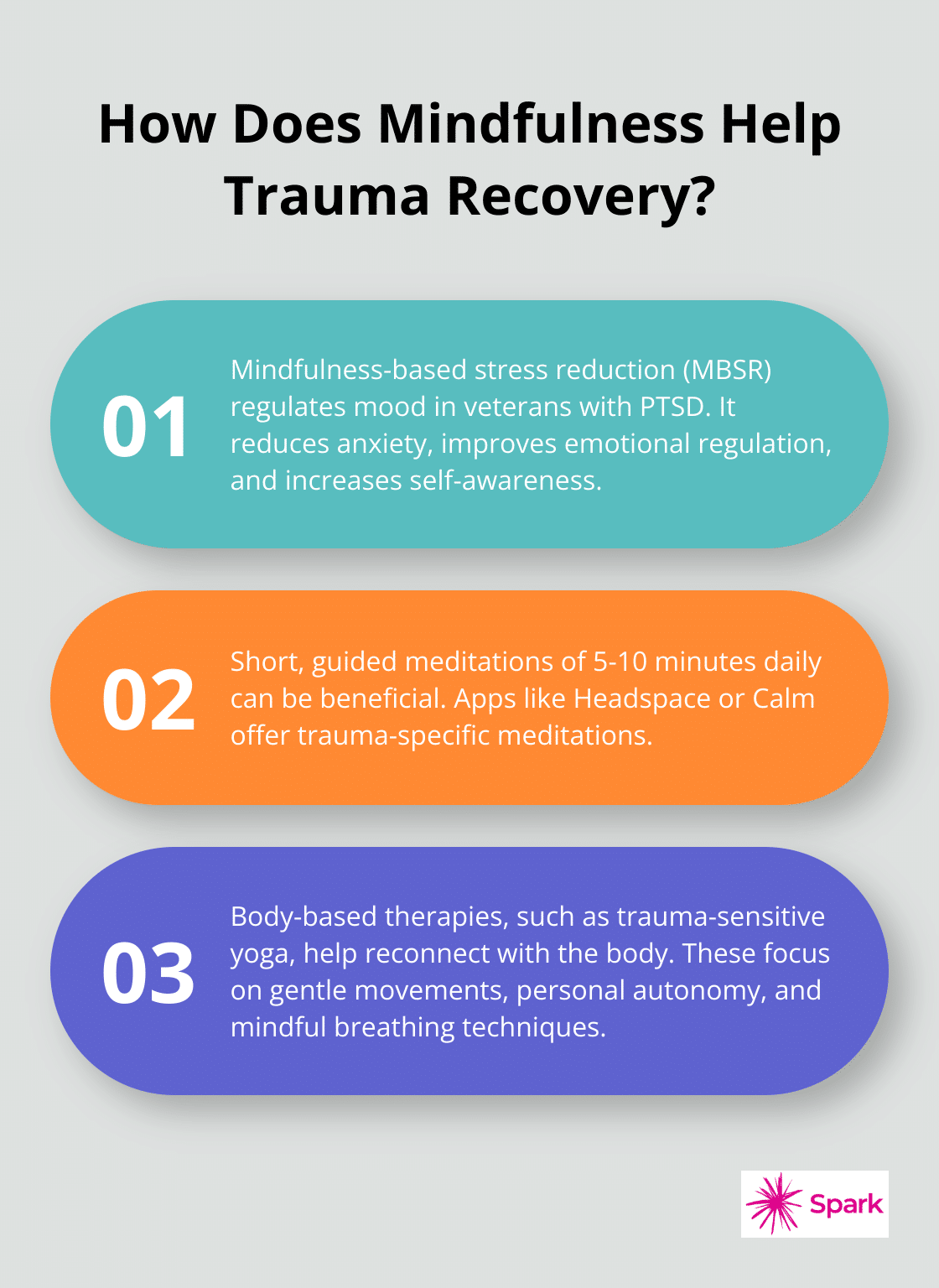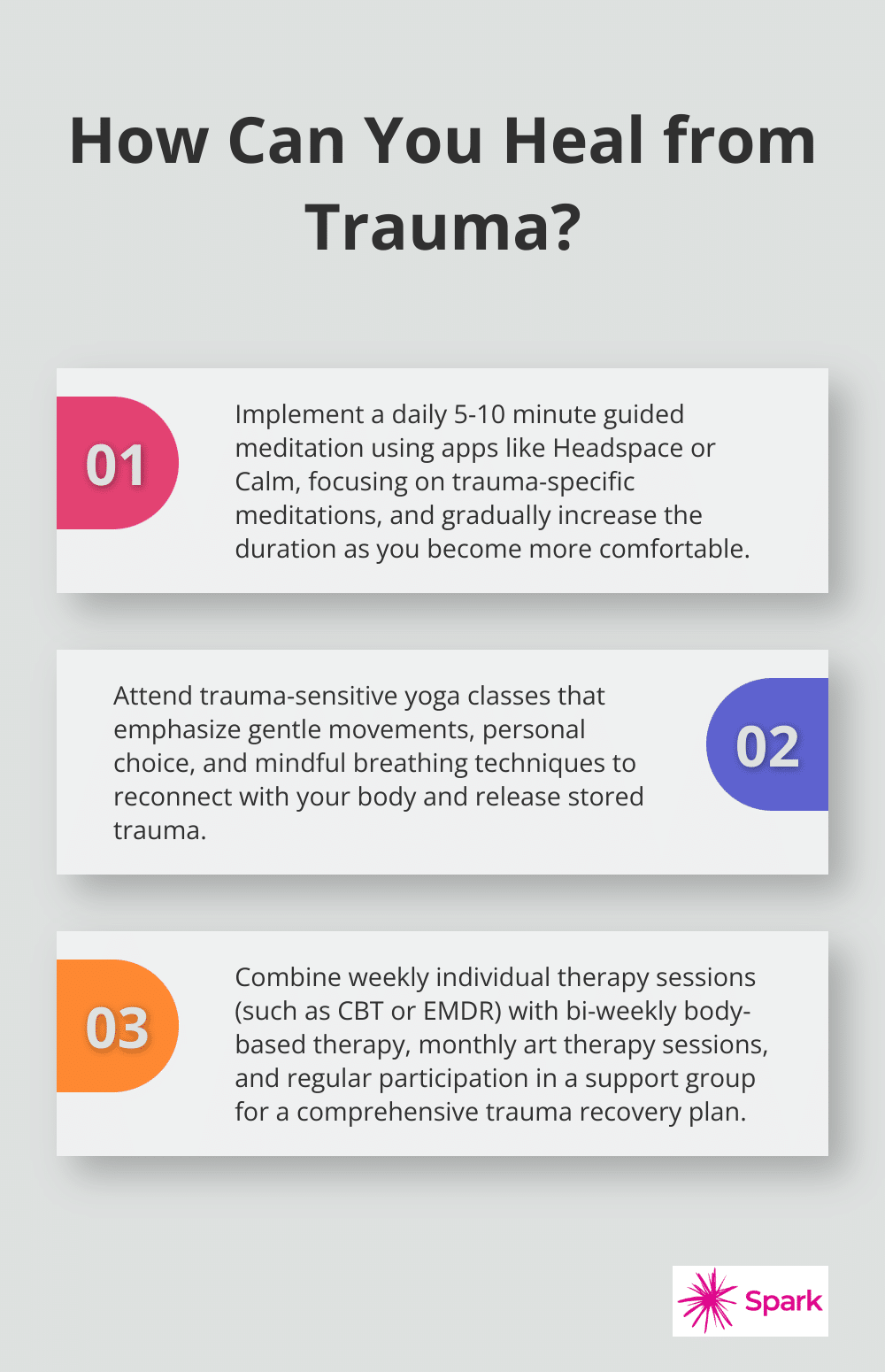Trauma can shatter lives, leaving deep emotional scars that persist long after the initial event. At Spark Mental Health, we understand the profound impact trauma can have on mental well-being.
In this post, we’ll explore the best therapies for trauma recovery, offering hope and practical guidance for those seeking healing. From evidence-based treatments to complementary approaches, we’ll uncover effective strategies to help you reclaim your life after trauma.
What Is Trauma and How Does It Affect Us?
Defining Trauma
Trauma extends beyond a mere bad experience. It represents a deeply distressing or disturbing event that overwhelms an individual’s ability to cope. Trauma can manifest in various forms, ranging from a single incident (like a car accident) to prolonged abuse or neglect.
The Diverse Nature of Traumatic Experiences
Trauma doesn’t follow a one-size-fits-all pattern. It can originate from a wide array of experiences:
- Physical or sexual assault
- Childhood abuse or neglect
- Natural disasters
- Combat exposure
- Witnessing violence
- Serious accidents or injuries
- Sudden loss of a loved one
About 6 out of every 100 people (or 6% of the U.S. population) will have PTSD at some point in their lives, highlighting the prevalence and lasting impact of trauma.
Identifying Trauma Symptoms
Trauma can produce far-reaching and varied effects. Common symptoms include:
- Flashbacks or intrusive memories
- Nightmares
- Severe anxiety or panic attacks
- Avoidance of trauma reminders
- Emotional numbness
- Hypervigilance
- Sleep disturbances
- Difficulty concentrating
- Irritability or angry outbursts

These symptoms can significantly disrupt daily life, affecting work, relationships, and overall well-being.
The Consequences of Untreated Trauma
Untreated trauma can inflict severe long-term consequences on mental health. The Adverse Childhood Experiences (ACE) study, conducted by the CDC and Kaiser Permanente, uncovered a graded dose-response relationship between ACEs and negative health and well-being outcomes. In other words, as the number of ACEs increases, so does the risk for negative outcomes.
Untreated trauma can lead to:
- Chronic anxiety and depression
- Post-Traumatic Stress Disorder (PTSD)
- Substance abuse disorders
- Eating disorders
- Self-harm behaviors
- Relationship difficulties
- Increased risk of suicide
A study published in the Journal of Traumatic Stress found that individuals with untreated PTSD were 80% more likely to develop depression compared to those without PTSD.
The Value of Professional Help
Recognizing the signs of trauma and seeking professional help plays a vital role in recovery. Early intervention can prevent the development of more severe mental health issues and improve overall quality of life. Telepsychiatry services (like those offered by Spark Mental Health) provide personalized, evidence-based treatment accessible from the comfort of one’s home, making it easier to take that first step towards healing.
Trauma recovery is achievable. With appropriate support and treatment, individuals can learn to manage symptoms, process their experiences, and reclaim their lives. In the next section, we’ll explore some of the most effective evidence-based therapies for trauma recovery, providing a roadmap for those seeking to overcome the impact of traumatic experiences.
Effective Therapies for Trauma Recovery
Cognitive Behavioral Therapy (CBT)
CBT stands as a cornerstone in trauma treatment. This therapy helps patients identify and change negative thought patterns and behaviors associated with their traumatic experiences. A study found that CBT clients improved significantly more than clients in treatment as usual (TAU) at posttreatment and 3- and 6-month follow-up assessments in PTSD symptoms.

In CBT, patients learn to:
- Recognize triggers
- Develop coping strategies
- Challenge and reframe negative thoughts
- Face feared situations gradually
CBT typically involves 12-16 weekly sessions, but the duration can vary based on individual needs.
Eye Movement Desensitization and Reprocessing (EMDR)
EMDR uses bilateral stimulation (usually eye movements) to help process traumatic memories. EMDR therapy is an empirically validated treatment for trauma, including such negative life experiences as commonly present in medical practice.
During EMDR sessions, patients:
- Recall traumatic memories
- Follow the therapist’s hand movements with their eyes
- Process the memory in a new, less distressing way
A meta-analysis published in the Journal of Clinical Psychology found that 84-90% of single-trauma victims no longer had PTSD after only three 90-minute sessions of EMDR.
Prolonged Exposure Therapy (PE)
PE works particularly well for patients who avoid trauma-related thoughts and situations. This therapy involves gradual exposure to trauma-related memories, objects, or situations in a safe environment.
PE typically includes:
- Education about common reactions to trauma
- Breathing retraining
- Real-world practice approaching feared situations
- Revisiting the trauma memory in a controlled setting
Narrative Exposure Therapy (NET)
NET proves especially useful for individuals who have experienced multiple or complex traumas. This therapy involves creating a chronological narrative of the patient’s life, focusing on both traumatic experiences and positive events.
During NET sessions, patients:
- Construct a detailed timeline of their life
- Discuss traumatic events in depth
- Process emotions associated with these events
- Integrate traumatic experiences into their life story
These evidence-based therapies offer powerful tools for trauma recovery. However, healing often requires a multifaceted approach. In the next section, we’ll explore complementary approaches that can enhance the effectiveness of these primary therapies and provide additional support on the journey to recovery.
Beyond Traditional Therapy: Holistic Approaches to Trauma Healing
The Power of Mindfulness in Trauma Recovery
Mindfulness and meditation practices show remarkable benefits for trauma survivors. A study found that mindfulness-based stress reduction (MBSR) is a useful method to regulate the mood state in veterans with post-traumatic stress disorder (PTSD). Mindfulness helps by:
- Reducing anxiety and hyperarousal
- Improving emotional regulation
- Increasing self-awareness
Try short, guided meditations for 5-10 minutes daily. Apps like Headspace or Calm offer trauma-specific meditations. Increase duration as you feel comfortable.
Reconnecting with Your Body
Trauma often disconnects people from their bodies. Body-based therapies can help rebuild this connection and release stored trauma. Yoga, in particular, shows promising results.

Consider trauma-sensitive yoga classes, which focus on:
- Gentle, accessible movements
- Emphasis on choice and personal autonomy
- Mindful breathing techniques
For trauma survivors, some mainstream yoga techniques can reactivate the fight-or-flight response, putting the sympathetic nervous system into overdrive.
Somatic Experiencing offers another powerful body-based approach. This therapy helps you tune into bodily sensations and release pent-up trauma energy. While best practiced with a trained therapist, you can start at home by noticing and naming physical sensations without judgment.
Expressing Trauma Through Art and Music
Art and music therapy offer non-verbal ways to process trauma, which can help when words feel inadequate.
You don’t need to be an artist to benefit. Simple activities like:
- Coloring mandalas
- Creating a collage of your emotions
- Listening to or creating playlists that resonate with your healing journey
can all provide therapeutic benefits.
The Role of Group Therapy and Support Groups
Group therapy and support groups add valuable layers to trauma recovery. These settings offer:
- Shared experiences and validation
- Peer support and encouragement
- Opportunities to practice social skills
Integrating Holistic Approaches with Traditional Therapy
While these holistic approaches offer significant benefits, they work best when combined with evidence-based therapies (such as CBT or EMDR). A comprehensive treatment plan might include:
- Weekly individual therapy sessions
- Regular mindfulness practice
- Bi-weekly yoga or body-based therapy
- Monthly art therapy sessions
- Participation in a support group
Healing from trauma takes time and patience. What works for one person may not work for another. It’s okay to try different approaches and see what resonates with you. The key lies in finding a combination that supports your unique healing journey.
Final Thoughts
Trauma recovery requires a personalized approach, often combining multiple therapies. Evidence-based methods like CBT, EMDR, PE, and NET form the foundation of effective trauma treatment. These proven therapies help process traumatic experiences and regain control over one’s life. Holistic approaches such as mindfulness, body-based therapies, and art therapy can enhance the healing process.

The best therapy for trauma varies from person to person. It’s essential to work with a mental health professional to create a tailored treatment plan. This plan should address your unique needs and experiences, incorporating the most effective therapies for your situation.
At Spark Mental Health, we offer personalized telepsychiatry services to support your healing journey. Our team of experienced professionals can help you develop a comprehensive treatment plan. With flexible online scheduling, you can access high-quality mental health care from home, making it easier to take that first step towards healing.






